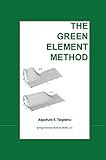The green element method [Libro electrónico] / by Akpofure E. Taigbenu
Por: Taigbenu, Akpofure E [autor/a].
Tipo de material: Libro
en línea Editor: Boston, Massachusetts, United States: Kluwer Academic, c1999Descripción: xv, 354 páginas : ilustraciones ; 24 centímetros.ISBN: 0792385101; 9781441950871 (Print); 9781475767384 (Online).Tema(s): Boundary element methods | Engineering mathematics | Finite differencesNota de acceso: Disponible para usuarios de ECOSUR con su clave de acceso Nota de bibliografía: Incluye bibliografía e índice: páginas 351-354 Número de sistema: 55575Contenidos:Mostrar
Resumen:
Libro
en línea Editor: Boston, Massachusetts, United States: Kluwer Academic, c1999Descripción: xv, 354 páginas : ilustraciones ; 24 centímetros.ISBN: 0792385101; 9781441950871 (Print); 9781475767384 (Online).Tema(s): Boundary element methods | Engineering mathematics | Finite differencesNota de acceso: Disponible para usuarios de ECOSUR con su clave de acceso Nota de bibliografía: Incluye bibliografía e índice: páginas 351-354 Número de sistema: 55575Contenidos:Mostrar
Resumen:| Tipo de ítem | Biblioteca actual | Colección | Signatura | Estado | Fecha de vencimiento | Código de barras |
|---|---|---|---|---|---|---|
| Libros | Biblioteca Electrónica Recursos en línea (RE) | Acervo General | Recurso digital | ECO400555755908 |
Incluye bibliografía e índice: páginas 351-354
1. Preliminaries.. 2. Linear Laplace/poisson equation.. 3. Nonlinear Laplace/poisson equation.. 4. Helmholtz equation.. 5. Transient diffusion.. 6. Transport equation.. 7. Burgers equation.. 8. Unsaturated flow (Richards equation.. 9. Higher-order elements.. 10. Steady two-dimensional problems.. 11. Unsteady two-dimensional problems.. 12. Further considerations.. Subject Index
Disponible para usuarios de ECOSUR con su clave de acceso
Most texts on computational methods are borne out of research activities at postgraduate study programs, and this is no exception. After being introduced to the boundary element method (BEM) (then referred to as the boundary integral equation method (BIEM)) in 1981 by Prof. Jim Liggett of Cornell University, a number of graduate students and myself under his supervision took active interest in the development of the theory and its application to a wide range of engineering problems. We certainly achieved some amount of success. A personal desire to have a deeper understanding and appreciation of computational methods prompted one to take related courses in fmite deference method, and to undertake a self-instructed study of variational and fmite element methods. These exposures were not only quite instructive but fruitful, and may have provided the motivation for the current research on the Green element method (GEM) - a name coined by Prof. Liggett in 1987 during my visit as Professor to the School of Civil & Environmental Engineering, Cornell University. The main objectives of this text are to serve as an instructional material to senior undergraduate and first year graduate students undertaking a course in computational methods, and as a resource material for research scientists, applied mathematicians, numerical analysts, and engineers who may wish to take these ideas to other frontiers and applications. eng
Disponible en línea
Disponible en formato PDF
Subscripción a ELSEVIER 26 de diciembre del 2013
